What’s common between Japanese and Mexican cooking
If I’m asked what’s common between Japanese and Mexican cooking, I will reply that vegetables are the main ingredients and the simple way of cooking with just a few seasoning so that the taste of products themselves stands out.
Actually I had never cooked Mexican dishes nor visited there but somehow I held this event “Cocinamos y comemos la comida Mexicana! (Let’s cook and enjoy the Mexican dishes together)” at the shared kitchen “Okatte Nishiogi.” One reason was I came across a female entrepreneur who helps people from overseas to interact with Japanese culture, and she once lived in Mexico City. Another reason was that I was so fascinated with the famous novel “Como agua para chocolate (Like water for chocolate)” and my perception of Mexican cooking was built on the story or delusions from it.
Checking up Mexican cooking books piled up on my desk during a prep, I found that recipes were not that mysterious – no tears dropping into a bowl, nor rose petals to color sauce and seduce those who eat it… On the contrary, a main seasoning is just salt, and sometimes pepper, oregano and cumin. They don’t use olive oil when they eat products raw, nor garlic… different from Spanish cooking. Instead, what make dishes distinctive are jalapeño, lime/lemon and, surprisingly, coriander.
Fortunately most of the ingredients are now available in Japan – fresh vegetables, seafood and meat, as lands with plenty of sunshine and mountains, surrounded by sea, which are another common things. What could not be procured locally were only jalapeño, corn flour, avocado, chickpea beans, and Latin American wines.
Here is the menu of the 3-hour event including cooking, eating and cleaning up altogether.
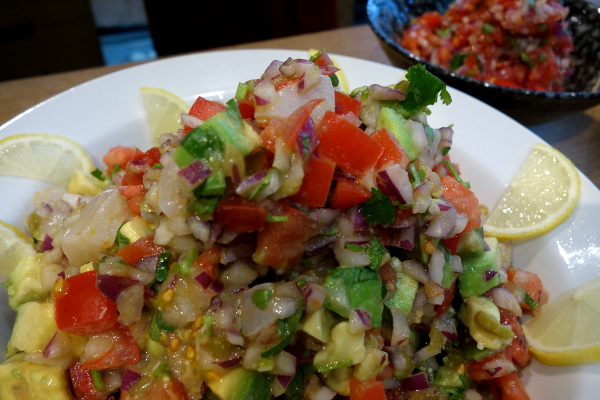
Coctel de vieira y aguacate (Scallop and avocado cocktail) – scallops, tomatoes, avocados, purple onions, jalapeños, green olive preserves, coriander, salt and lime/lemon
帆立とアボカドのカクテル(材料12名分:刺身用帆立10~12個、トマト3個、アボカド3個、玉ねぎ小1個、ハラペーニョ1~2本、グリーンオリーブ12個、コリアンダー、塩、ライム)
1.塩少々と白ワイン少々を入れた水を沸かし、帆立をさっと茹でて冷ます(茹ですぎずに生っぽさを残すと美味!)
2.トマトとアボカドを角切り、玉ねぎ、ハラペーニョ、グリーンオリーブ、コリアンダーをみじん切り(紫玉ねぎを使うと彩りがきれい)
3.1と2の具材をボウルに入れ、塩とライム(またはレモン)搾り汁で味付け
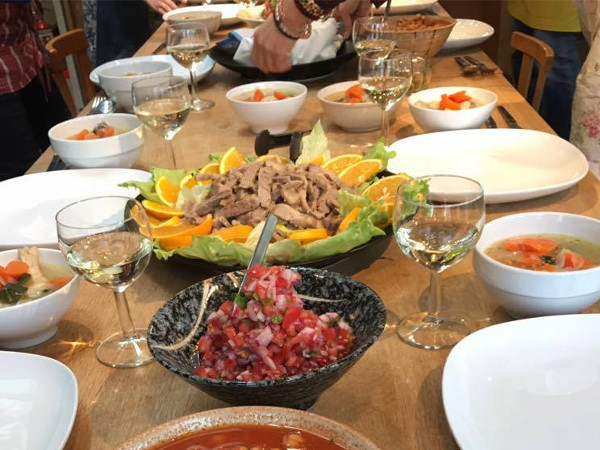
Salsa Mexicana – tomatoes, jalapeños, purple onions, coriander, salt, lime/lemon
サルサ・メヒカーナ<基本のサルサ>(材料12名分:トマト4個、ハラペーニョ2本、玉ねぎ1個、コリアンダー、塩、ライムまたはレモンの搾り汁)
1. トマト、ハラペーニョ、玉ねぎをみじん切り、コリアンダーは粗みじん切り
2.材料を混ぜて、塩とライム(またはレモン)搾り汁で味を調える(少し時間をおいてなじませた方が美味しい)
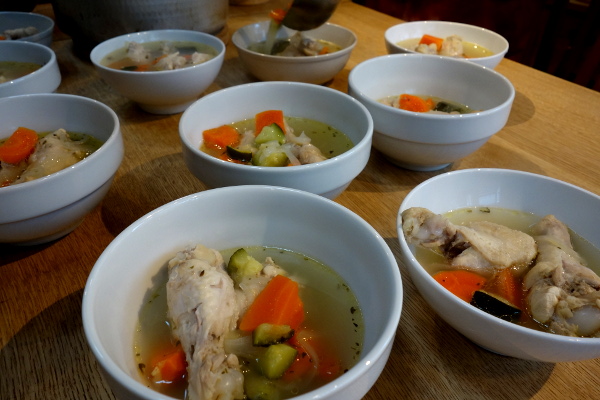
Caldo de pollo (chicken soup) – chicken wing sticks, onions, carrots, zucchinis, salt, oregano, chicken soup stock
鶏のスープ(材料12名分:鶏手羽元24本、水適宜、玉ねぎ1~1.5個、にんじん2~3本、ズッキーニ1~2本、塩、オレガノ、適宜無添加の鶏顆粒スープ)
1.玉ねぎを薄くスライスし、にんじんとズッキーニを食べやすい大きさに切る
2.鍋に水、鶏、玉ねぎ、にんじん、ズッキーニ、塩、オレガノを入れて煮込む
3.味見をしながら、適宜鶏顆粒スープと塩を足しながら煮込む(本格派の方は、まず鶏ガラでスープをとって… 実はそれが本場のメキシコ流)
4.器によそったあと、お好みでサルサ・メヒカーナを足してどうぞ
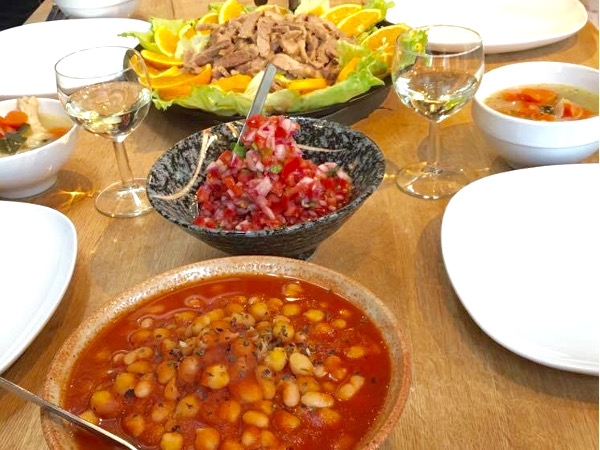
Frijoles (beans simmered with tomato) – kidney or chickpea beans, onions, whole tomato, salt, oregano, olive oil
豆の煮込み(材料12名分:インゲン豆またはヒヨコ豆 600g、玉ねぎ2個、ホールトマト1缶、塩、オレガノ、オリーブオイル)
1.豆はさっと洗い、前日夜から一晩水に漬ける
2.適宜豆がかぶる程度に水を足して、中火にかける
3.玉ねぎとホールトマトをミキサーにかけて、なめらかなペースト状にする
4.2の豆に、3のペーストを加えてさらに煮る
5.豆がつぶれるぐらいになったら、塩、オレガノ、オリーブオイルを加えて味をなじませる

Carnitas (Pork simmered with oranges) – pork loin, oranges, orange juice, salt, pepper, oregano, cumin.
豚のオレンジ煮(材料12名分:豚ロース肉1キロ、オレンジ2個、オレンジジュース2カップ、塩、胡椒、オレガノ、クミン)
1.豚ロース肉の筋切りなど下処理する
2.豚肉に塩、胡椒、オレガノをまぶす
3.鍋に豚肉とオレンジジュースを入れて弱火で煮込む。焦げ付かないように!
4.40~50分煮込んで、お好みでクミンを加える
5.トルティーヤにはさむので、食べやすい大きさに切る

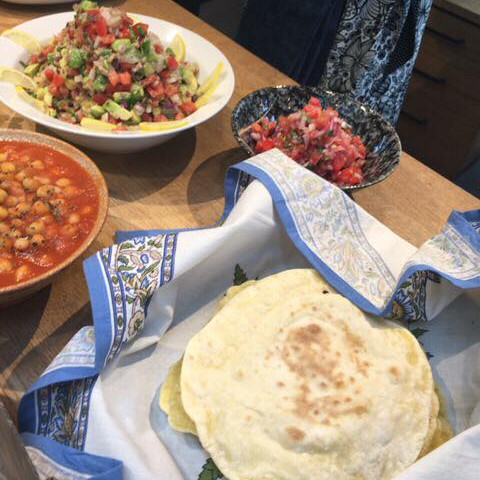
Tortilla (corn and flour pancake) – corn flour, wheat bread flour, salt, cooking oil, water
トウモロコシ粉と小麦粉のトルティーヤ(材料12名分:コーンフラワー300g、強力粉300g、塩小さじ2強、サラダ油大さじ6、水450ml、クッキングシート、麺棒)
1.ボウルにコーンフラワー、強力粉、塩を入れて泡だて器で混ぜ、サラダ油を加えて手でパラパラになるまで混ぜる
2.さらに水を少しずつ加え、ひとまとまりになるまで練る
3.打ち粉をした台に取り出して、棒状に伸ばし、24~30ぐらいに等分する
4.さらに打ち粉をして、1個を直径15~20センチの円形に伸ばす(麺棒や、カッティングボード、鍋などを利用) くっつきやすいので、クッキングシートで挟む
5.テフロンのフライパンに油をひかずに並べ入れ、両面を1~2分ずつ焼く
6.焼きあがった生地は乾燥しないように、濡れ布巾などに包んでおく
※本来はマサと呼ばれるトルティーヤ専用のトウモロシ粉や消石灰などを使うようですが、今回は失敗を避けるために「コーンフラワー+小麦粉(強力粉)」で作りました。今回、一番の難関がこのトルティーヤでした。

Wine recommendation from an expert – sauvignon blanc for appetizers, pinot noir and carmenere for chicken and pork. All from Latin America.
野菜とシーフードメインの前菜にはチリのソーヴィニョン・ブランを、鶏と豚にはやはりチリのピノ・ノワールとカルメネールを合わせました。okatteにしおぎの昼の部では、アルコールはあまり消費されないのですが、この集まりではあっという間になくなってしまいました。
「妄想ニホン料理」という番組が好きでよく見ていたのですが、わたしの場合むしろ「妄想メキシコ料理」で、小説「赤い薔薇ソースの伝説」(ラウラ・エスキヴェル)を読んで膨れ上がった妄想でイメージが出来上がっていました。メキシコには行ったことがなく、メキシコ料理を作ったのもこれが初めてでしたが、予想に反してすごくシンプルな調理法で、素材の美味しさが決め手なんだなと思いました。トマトをはじめとする美味しい野菜とちょうどよく熟れたアボカドが手に入ったら、メキシコ料理はおすすめです。
この投稿へのトラックバック
トラックバックはありません。
- トラックバック URL



この投稿へのコメント